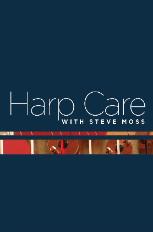Happy New Year!
While you’re putting together your list of resolutions for this year, how about instituting a string replacement schedule?
Your harp only sounds as good as its strings, and unfortunately strings do deteriorate with age and use. While it is obviously necessary to replace strings when they break, I would also advise you to adopt a regular schedule of replacing your strings even if they don’t.
Without a regular replacement schedule, you might have an octave that includes two strings you just replaced, two more that you replaced a year ago, and four that have been on the harp for longer than you can recall. Hey, it’s great that those four strings never broke, right? Saves you some money, and we all know how expensive gut harp strings are. But that mixed-vintage octave is not going to make your harp sound as good as it should. Newer strings have more resonance and sustain than old ones, and as a result, your harp will sound uneven in tone. In addition, you may have most of your harp strung in gut, but there is the odd nylon string that you threw on in an emergency at a gig. While you had to do it at the time, now it sounds and feels different than the others. You mean to change it, you really do, but there just hasn’t been time.

No more false strings. Change those darn things!
I’m not saying you need to replace all of the strings on your harp every year, or even every two years. Some strings can sound good for much longer than that. Others tend to wear out more quickly. I will outline some proposed schedules below that break things down by octave, and you can you can choose one that best fits your budget and your goals for your harp’s sound.
The strings that should be replaced most often are at either end of the harp. The top two octaves need changing more frequently because, due to their short lengths, any slight wear or damage can affect the harp’s ability to stay in tune as you change pedal positions. Over time, divots form where the strings are gripped by the mechanism. These divots can throw off the harp’s intonation and lead to unwanted snapping as well.
At the other extreme, bass strings are not subject to the same kind of wear, but they lose a lot of their brightness and sustain over time. This change is insidious because it happens slowly and as you play from day to day you won’t notice the change. Once you change all of them, you will think you have bought a new harp, the sound will be so different. Since it’s hard to judge when your own harp’s wires are too old, adopt a schedule and replace them regularly, and you will never have to play tubby, dead-sounding wires again.

There, that wasn’t so bad, was it?
My esteemed colleague and mentor, Peter Wiley, put together a choice of three string replacement schedules and posted them on his website, harpdoc.com. With his permission, I am reprinting them here. As the new year gets rolling, why not pick one of these plans for the coming years? You can put some alerts on your Google calendar to remind you when to buy strings. The only change I might make to this list would be changing the name of the third, or “average” level. Frankly, if you replace your strings as often as recommended here, your harp will definitely sound above average compared to many of the harps that I see and hear on a daily basis. So, with homage to Peter, I am renaming “average” to “excellent.”
Following the guidelines below you will help to keep the voice of your harp sounding at its best. When you’re estimating the cost of the various options, remember that the first and second octave strings are double (sometimes triple) length. Some manufactures now package the third octave in double length.
If the sound you want is:
Extraordinary
- 1st, 2nd and 3rd: Once yearly (possibly twice)
- 4th and 5th: Every three years
- Bass Wires: Once yearly
Professional
- 1st and 2nd: Once yearly
- 3rd: Every other year
- 4th and 5th: Every four to five years
- Bass Wires: Once yearly
Excellent (was Average)
- 1st and 2nd: Every two years
- 3rd: Every three years
- 4th and 5th: Every five to six years
- Bass Wires: Every two to four years
Want to get great articles like this delivered to your email inbox? Join the mailing list now!


Thank you for such a useful article! I find it interesting that the 4th & 5th octaves strings don’t need replacing as “often” as the others …